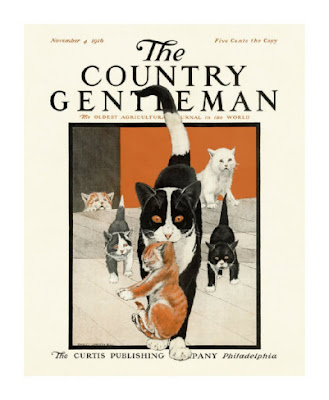(This is my copy of Understood Betsy here on the right, on the actual bamboo bookcase.)
The winter in this book is satisfyingly cold, the way winters should be. Understood Betsy is set in Vermont, in an old farmhouse whose windows are rattled by icy winds. The snow piles up so deeply there that falling into a snow drift is like falling into a cavern. At first, Betsy doesn't like the idea of cold weather. It scares her, and she can't see any beauty in the cold countryside:
"She shrank together in her seat, more and more frightened as the end of her journey came nearer, and looked out dismally at the winter landscape, thinking it hideous with its brown bare fields, its brown bare trees, and the quick-running little streams hurrying along, swollen with the January thaw which had taken all the snow from the hills."
(Betsy arriving in Vermont and being allowed to drive her uncle's horses, illustrated by Ada C. Williamson, 1916.)
But a few months later she has totally adjusted to cold weather. We see her running happily through the frozen woods with her family's huge dog, rescuing her friend from a snow drift, and making maple sugar candy in the snow:
"She found a clean white snow-bank under a pine-tree, and, setting her cup of syrup down in a safe place, began to pat the snow down hard to make the right bed for the waxing of the syrup. The sun, very hot for that late March day, brought out strongly the tarry perfume of the big pine-tree. Near her the sap dripped musically into a bucket, already half full, hung on a maple-tree. A blue jay rushed suddenly through the upper branches of the wood, his screaming and chattering voice sounding like noisy children at play."
( I will always be fascinated by snow candy! Here is a tutorial on making it. Maybe I'll try it this year when I'm visiting my family in the snowier regions of the U.S..)
In 1916 New England, winter seems to last for three seasons -- March and October are just as cold and snowy as January. That helps to make Understood Betsy the coziest book ever. The farmhouse has a warm kitchen with a tea kettle perpetually humming on the stove, and every possible cozy thing happens in that kitchen. Making popcorn, baking pies, reading out loud by lamplight, listening to the dog snore. And the kittens! Oh, the kittens.
(There is a reason why the cover is full of kittens, and the reason is that this is one of the greatest kitten books ever written.)
I remembered this book from my childhood as being primarily about kittens. Maybe that's partly because of the kittens on the cover, but I think it's mostly because Understood Betsy features incredibly cute kittens doing incredibly cute things. The book isn't really about kittens, though; it's about children's education. It's about Betsy's journey from her city life, where she's sheltered and spoon-fed, to her country life, where she learns to be independent and think for herself. Dorothy Canfield Fisher was an advocate for educational reform. But let's not forget that she was also an amazing describer of kittens, because that's pretty important too.
(Charles Livingston Bull, "Kittens with Mother," 1916. This print reminds me of the scene where Betsy's cat Eleanor carries her kittens inside to keep them warm for the winter.)
Winter is important in Understood Betsy. In the city, Betsy is told that she's sickly, and she's never allowed to feel cold. Once she gets to the country, though, she's allowed to run around in the cold, and it makes her stronger. By the end of the book, Betsy and her dog are "careering through the air like bright-blown autumn leaves" -- it's like she's part of the winter landscape now.
(Betsy's friends help her get used to playing outside in this illustration by Ada C. Williamson.)
Also, the cold Vermont weather is always being contrasted with the warmth of the farmhouse, and the warm hearts of the people who live there. Winter in this book is all about interior coziness and exterior merriment. And that's exactly what I want for my winter this year.






"[O]ne of the greatest kitten books ever written": that is a brilliant way to grab my attention. Enjoyed your review, and I will have to read this now!
ReplyDeleteThanks! Basically, any author can win me over with a well-written cat.
DeleteI just read Understood Betsy for the first time - and I loved the kittens! Not to mention the maple sugar candy - to which I became addicted when I lived in Massachusetts.
ReplyDeleteI've also just come across your blog, and I look forward to exploring it. Your winter books are some of my favorites.
Thanks so much! I'm planning to review some more of those winter books soon.
Delete